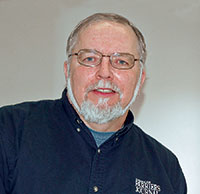During my years at American Farriers Journal, I’ve done more than 50 of our “Shoeing For A Living” profiles. I’ve also spent many other days in the field with farriers on other assignments.
I’ve accompanied farriers who worked by themselves and those who worked with one or more apprentice. I covered informal partnerships, where a few farriers got together for a day to tackle a busy barn, and I’ve ridden along with teams from multi-farrier practices.
I think maybe the largest group I ever rode along with was in Wellington, Fla., where James Gilchrist and his crew rolled into show barns with two full shoeing rigs and four farriers, all ready to go to work.
Teamwork
The advantages to these situations are obvious. More farriers can do more horses. One member of a crew may know of a way to treat a foot issue that others do not. A shared workload can be less physically taxing and working under the direction of a more experienced farrier is essential for those just starting out in the business.
There’s also the safety factor. Having other farriers around can be a lifesaver in the event of something going wrong.
But there are benefits to working alone, as well. Matt Frederick, a veteran farrier from Napa, Calif., shared some thoughts about this during a day I spent with him last October.
Frederick believes that when he works alone, he’s totally focused on the horse and its needs throughout the appointment.
A farrier working alone cleans the hooves, pulls the shoes, moves on to the trimming and shoeing and does all the work him or herself, right through the clinching and finishing.
Frederick says this extra time spent on one horse, handling its feet though all phases of the process, gives him a better opportunity to learn about what’s going on with them; to spot changes and potential problems.
More Production, But Less Hoof Care?
He thinks it’s possible that these things can be missed if a farrier is doing one part of the job — say, trimming the hooves — then moves on to do the same thing on the next horse and the one after that. The goal can become increased production, rather than better hoof care.
There are ways to make sure this doesn’t happen. I’ve been with farrier teams that, rather than taking an assembly-line approach, have each member do all the work on individual horses. Gilchrist, the Florida farrier mentioned earlier, is more than just another farrier in a multi-farrier operation. He’s the one in charge.
During the day that AFJ Technical Editor Red Renchin and I spent in Wellington with him, he carefully directed the work of each member of his crew and examined each horse before, during and after the work. This helps ensure that what’s paramount is the needs of the horse, not increased production.
And it’s also possible for production to get in the way of hoof care for a single farrier. If you’ve scheduled too many horses in a day, it can be hard to keep to control the pressure to get each horse done so you can move on to the next one. This is particularly true near the end of the day as you tire.
Focus On The Horse’s Needs
As it always seems to, the way to solve this potential problem is to keep the horse and its needs at the center of a day’s work — whether it’s by one farrier, a farrier and apprentice, or a larger crew.
Put the horse first and good hoof care will follow — and that can only benefit your business.
Coming In The March AFJ:
A Shoeing For A Living Retrospective
I spent my first full-day with a farrier for a “Shoeing For A Living” story in November 2000, riding along with Monica Hoff, of Green Bay, Wis. Last October, the day I spent with Matt Frederick of Napa. Calif., was the 56th. In the March issue of American Farriers Journal, I’ll be looking back at those days and sharing some of the best advice from the farriers and veterinarians who were so generous with their knowledge and time.








Post a comment
Report Abusive Comment